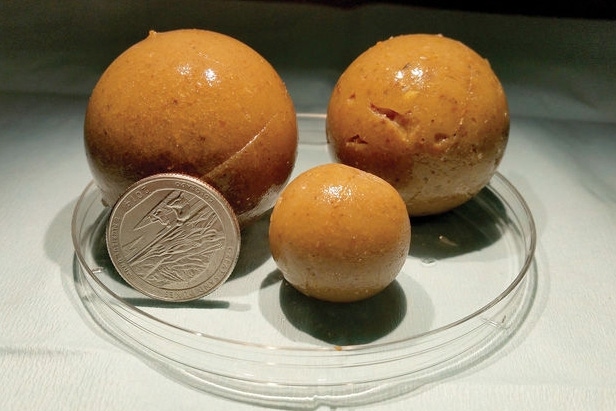LSU researchers receive patent for feral hog bait
Bait lethal to feral swine, but has minimal impact on the environment and nontarget species.
August 11, 2023

After years of research aimed at finding an effective way to control exploding populations of feral hogs, a patent has been issued for a bait developed by scientists with the Louisiana State University AgCenter and LSU Department of Chemistry.
The bait uses sodium nitrite, which is lethal to feral swine, the culprits behind millions of dollars in damage to agricultural fields and forestlands in Louisiana and across the country. But the bait has minimal impact on the environment and nontarget species. With a consistency similar to gummy bears, it is shaped into golf ball-sized spheres, tastes fishy and even glows under blacklight.
The patent was issued Aug. 8 to LSU with the inventors listed as Glen Gentry, an animal scientist and director of the LSU AgCenter Bob R. Jones-Idlewild Research Station in Clinton; John Pojman, an LSU chemistry professor; and Baylen Thompson, a former graduate student who worked under Pojman.
“This is a milestone for us,” Gentry said.
The bait has been in the works for several years. Scientists began looking for a solution as problems with feral hogs grew in rural areas.
In Louisiana alone, the feral hog population has doubled in the past decade, with their numbers currently estimated at about 1 million. They travel in packs and are known for rooting up fields in search of food. AgCenter experts have determined they cause about $91 million in damage every year in the state.
The hogs have a rapid reproductive rate that has complicated population control efforts. A sow can have two litters of about six piglets yearly, outpacing the number of hogs that can be removed from the landscape through hunting and trapping.
The bait offers a more effective control method with the bonus of being humane, Gentry said. Within three hours of consuming the bait, hogs become sleepy and die.
Sodium nitrite is an ideal toxicant, he said, because it is deadly to swine and eventually breaks down into compounds that do not harm other species or pose environmental concerns.
Pojman and his students were instrumental in adjusting the pH of the bait matrix to stabilize the sodium nitrite, slowing down the conversion to nonlethal compounds so hogs have enough time to consume the bait.
It took many tries over the years to develop a bait that worked and that hogs would be willing to eat. Gentry and his team tried various ingredients to entice the hogs before landing on dehydrated fish.
The rubbery texture is critical, as it helps ensure the bait doesn’t fall apart when hogs bite into it. That limits the amount of scraps on the ground and helps protect nontarget species. Fluorescence is added into the matrix to make it easy for users to see whether any pieces are left behind by shining a blacklight.
The scientists are now focusing on conducting additional field trials and studies on shelf life. They also are looking for the best ways to deliver the bait, with possible solutions including burying the bait so hogs can root it up or releasing it from a feeder using a cellphone.
“All of this is required before it can be approved by the EPA and released to the public,” Gentry said.
Stakeholders were instrumental in providing funding for the bait research. Among them are Ann Reiley Jones, the Irene W. and C.B. Pennington Foundation, the Bob R. Jones Wildlife Research Institute, the Louisiana Soybean and Grain Research and Promotion Board, the Louisiana Rice Research and Promotion Board, the Louisiana Legislature and the Louisiana Department of Wildlife and Fisheries.
You May Also Like


.png?width=300&auto=webp&quality=80&disable=upscale)
